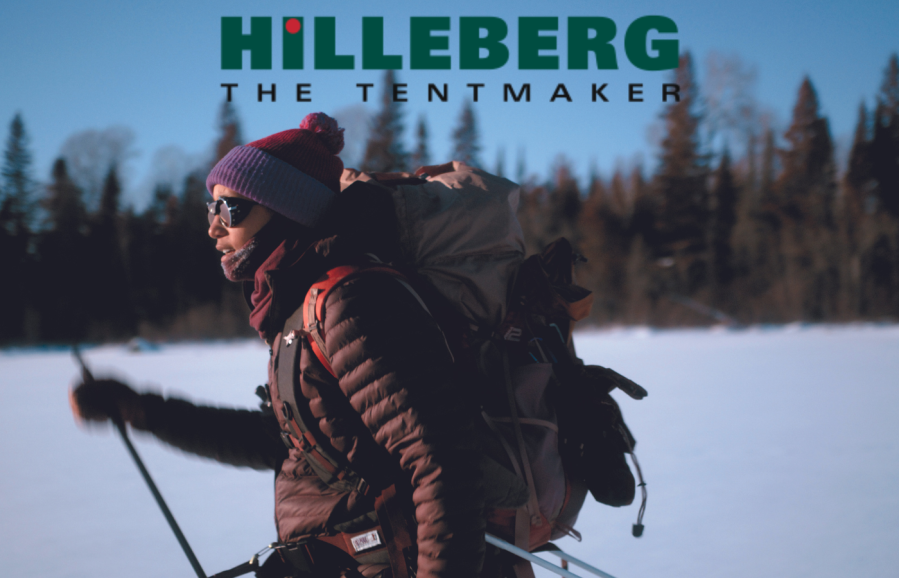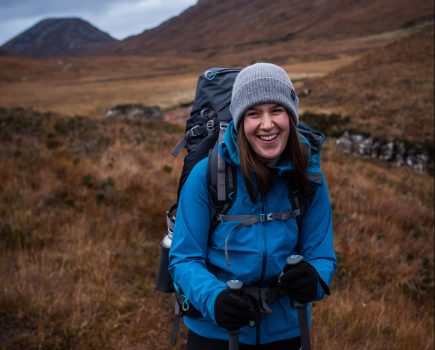As the first woman and person of colour to complete the 1,200-mile Ice Age Trail, Emily Ford explains how she transforms a tent into a home in the depths of winter.
Main photo: Jesse Roesler
As a child, Emily Ford spent her summers doing exactly what she does now: happily playing outdoors. “I was this dirty kid that never wanted to come inside,” she says. In adulthood, she’s in charge. In the summer, she is the head gardener at the Glensheen mansion in Duluth, Minnesota. In the winter, when most retreat indoors as the state freezes over, Emily stays out and embraces the cold. Her childhood love for being outside led her to intimately understand that outdoor fun doesn’t have to end with the arrival of snow.
She began with short winter walks and, over time, came to find joy, solace, and deep perspective on long hikes in the snowy landscape. “You realize nature has its own systems – has its own rhythms. I’m entering into, not orchestrating it myself. I’m literally just a visitor here,” she says.
This advertising feature is sponsored by our friends at Hilleberg
In 2021, Emily became the second known person to complete Wisconsin’s Ice Age Trail in the wintertime, and the first woman and person of color. She and her pup Diggins spent 69 days on trail and, on many cold nights, were lulled to sleep by distance wolf calls. The lengthy 1,200-mile (1,931 km) trek only made Emily want to get out more.

Emily crosses a frozen lake, a common occurrence on her trek through the Boundary Waters Canoe Area (BWCA) in Minnesota, USA. | Photo: Jesse Roesler
“Once you do it once, you realize how amazing it is. I can’t even describe it. You’re getting to places that you can only see by foot, ski, or dogsled. These aren’t places you can see if you drive there,” Emily says.
“Nature has its own systems – its own rhythms…I’m not orchestrating it myself. I’m just a visitor here.”
Her home isn’t known for having the most drastic topography, but it does see very extreme weather. “I’m a Midwesterner and yet there are [amazing] trips I can go on – that you could go on too,” she says. Minnesota can see lows of -39°F (-39° C) and has seen as much as 7ft (2m) of snowfall within a year. Paradise for Emily.
“Trips are going to look different to me than all these people who live out west or out east who live in the mountains,” she says. “We got crushed by a glacier eons ago so it’s flat.” But just because she’s not summiting mountains, it doesn’t make her trips less significant.
Enjoying the outside and doing a bit of self-discovery is something anyone can do. In fact, it’s something Emily wishes everyone would do. “It’s the thing I always wish I could give to people as a gift – just grabbing a tent and sleeping outside for multiple nights.” That perspective is a big part of why Bo Hilleberg first started making tents in the early 1970s. It doesn’t matter if you’re doing a multi-month winter trip (like Emily), taking a leisurely summer weekend backpack excursion or doing another trip into the backcountry in any season, spending a night in a Hilleberg tent means being comfortable no matter where you are.
After the Ice Age Trail, Emily wanted more. In 2022, she and Diggins embarked on their next adventure: A ski crossing of the Boundary Waters Canoe Area in northern Minnesota on the Voyageur’s Highway which runs along the border of Minnesota and Canada. Emily’s 210-mile (338km) route required countless treks across frozen lakes. “On some of those big lakes, it’s just big wind. You’re skiing all day into the wind or the wind’s hitting you from all different sides. All you want is protection and it’s just ripping icy snow at you,” Emily says.
When they reached camp, Emily pitched her Nammatj GT while Diggins sat, watched and waited eagerly, knowing they would both soon be warm again. “It’s amazing how warm you can be with no wind,” Emily says.
Even though Emily and Diggins cuddled together every night in the tent, she greatly appreciated roominess of her Nammatj GT on the BWCA trip. Its extended vestibule had plenty of room for bulky snow gear, food prep, or even her dog, but it also allowed for some creative expression. Emily’s interior design skills, she laughs, are “off the charts.” The frozen lakes she often camped on could have 3 to 4ft (0.9 to 1.2m) of snow to dig into, plenty to make fully customized storage shelves and other “snow furniture” in the vestibule. “It was literally the highlight of my day,” she says.
“My tent is like my home,” says Emily, and it’s easy to see why. The Nammatj GT has an excellent space to weight ratio that was very welcome on such a demanding trip. Its strong Kerlon 1800 outer tent fabric and 10mm poles easily stood up to the stormy conditions she encountered. And because the outer tent walls go all the way to the ground, Emily knew that wind and snow would stay on the outside while she was snug on the inside. Her Nammatj GT not only kept her (and Diggins) sheltered from blizzard conditions, but pitching it, customizing it and finding rest in it became vital to the camp ritual they so looked forward to.

Hilleberg is home and home is Hilleberg! Emily and Diggins are all smiles in front of their Nammatj GT. Photo: Emily Ford/@emilyontrail
A trustworthy tent keeps complications to a minimum so you can focus on being better prepared for the next day. “You can tackle almost any trip as long as you’re getting good sleep,” Emily says. It also helps you focus on enjoying the journey. “On trail, your purpose is really simple. I think that’s something that people really crave, they just don’t know it. I mean, don’t get me wrong, trips can be really complicated – really complicated – but it’s a different complicated than normal life,” Emily says.
Adventures, including Emily’s, are taken step by step and with little celebrations along the way. “It’s like tiny doses of serotonin and little pats on the back. And then all of a sudden, you’re done with your trip!” she says. It doesn’t matter how many or how few steps your journey entails, only that you choose to take the first one. “You can ask all these people about their experience, but at the end of the day, you just have to go and do it. You have to be the one to step outside the door.”







